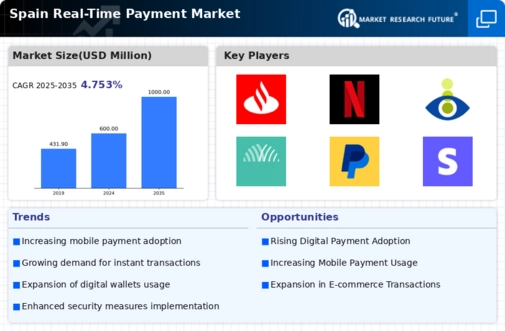Evolving Regulatory Landscape
The evolving regulatory landscape in Spain is significantly influencing the real time-payment market. Regulatory bodies are increasingly recognizing the importance of digital payment systems and are implementing frameworks to support their growth. Recent regulations have aimed at enhancing consumer protection and ensuring the security of transactions. This supportive environment is likely to encourage more players to enter the market, fostering competition and innovation. As of November 2025, it is anticipated that the regulatory framework will continue to evolve, further facilitating the expansion of the real time-payment market and enhancing consumer trust in digital transactions.
Increased Focus on Financial Inclusion
Financial inclusion is emerging as a critical driver for the real time-payment market in Spain. The government and various organizations are actively working to provide access to financial services for underserved populations. Initiatives aimed at promoting digital literacy and access to mobile banking are gaining traction. As a result, the real time-payment market is likely to see an influx of new users, particularly from rural areas where traditional banking services are limited. Reports suggest that enhancing financial inclusion could potentially increase the number of active users in the real time-payment market by up to 25% over the next few years.
Rise of E-commerce and Online Services
The rise of e-commerce and online services is a substantial driver for the real time-payment market in Spain. As more consumers turn to online shopping, the demand for efficient payment solutions is escalating. Data indicates that e-commerce sales in Spain have increased by over 30% in the past year, highlighting the need for real-time payment options to facilitate seamless transactions. Businesses are increasingly adopting real time-payment solutions to enhance customer satisfaction and reduce cart abandonment rates. This trend suggests that the real time-payment market will continue to thrive as e-commerce expands, providing consumers with the speed and convenience they desire.
Growing Consumer Demand for Instant Transactions
The real time-payment market in Spain is experiencing a notable surge in consumer demand for instant transactions. As individuals increasingly seek immediate access to their funds, the market is adapting to these expectations. Recent data indicates that approximately 70% of consumers prefer payment methods that offer real-time processing. This shift is compelling financial institutions to enhance their offerings, ensuring that transactions are completed within seconds. The growing reliance on digital platforms for everyday transactions further fuels this demand, as consumers expect seamless experiences. Consequently, the real time-payment market is likely to expand, driven by the need for speed and convenience in financial transactions.
Technological Advancements in Payment Infrastructure
Technological advancements are playing a pivotal role in shaping the real time-payment market in Spain. The integration of innovative technologies, such as blockchain and artificial intelligence, is enhancing the efficiency and security of payment systems. For instance, the implementation of blockchain technology is expected to reduce transaction times significantly, potentially lowering costs associated with traditional payment methods. As of November 2025, it is estimated that around 40% of financial institutions in Spain are investing in upgrading their payment infrastructure to support real-time capabilities. This trend indicates a strong commitment to improving the overall consumer experience within the real time-payment market.

















Leave a Comment